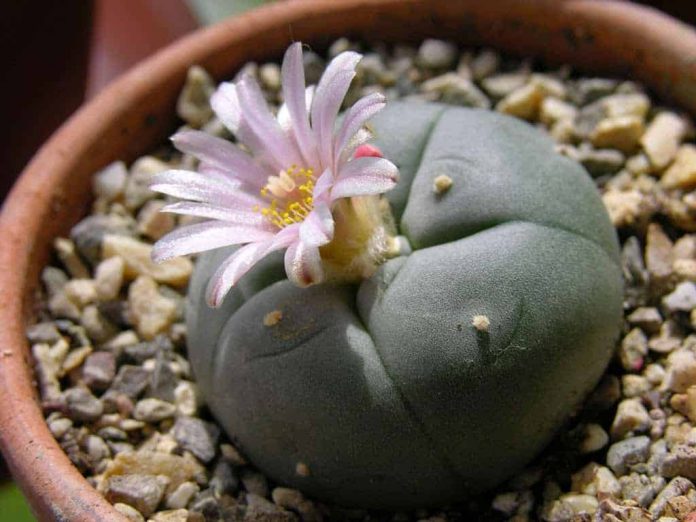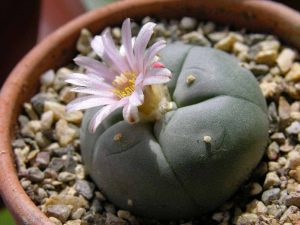Mescaline is a naturally occurring psychedelic found in several cactus species, most notably, Peyote (Lophophora williamsii) and San Pedro (Trichocereus pachanoi) native to northern Mexico and the southwest United States. Several other members of the trichocereus family also contain mescaline.
Mescaline belongs to a family of compounds known as phenethylamines, making it quite distinct from the other major psychedelics which belong to the indole family. LSD, psilocybin, harmaline, and DMT are all indoles. Many synthetic “designer” psychedelics, such as ecstasy (MDMA) and 2C-B, are phenethylamines, and are related to the chemistry of mescaline. It was the first psychedelic drug to enter mainstream US culture, long before LSD and psilocybin.
In addition to containing mescaline, the cacti mentioned above contain a large variety of related psychoactive compounds, and will produce experiences that are qualitatively different than pure mescaline. The experience produced by Peyote is also quite distinct from that produced by cacti from the trichocereus family.
The literature I’ve read indicates that many members of the trichocereus family are psychoactive. I’ve only tried three or four of these and found them to be basically equal in potency. Many references indicate that one variety, Trichocereus peruvianus, is several times as potent by weight as the other trichocereus species.
History
Peyote and San Pedro are New World psychedelics. In ancient times their use was concentrated in the regions to which they are native. Peyote was used throughout Mexico to as far north as Texas, San Pedro in the Andes mountain region of South America. A 2005 study found traces of peyote in Native American ruins that date back at least 5,700 years, making this its earliest known use.
Peyote was used extensively in pre-columbian tribal rituals throughout modern-day northern Mexico and the southern plains of the United States. Various accounts and evidence suggest it first used by the Tonkawa, the Mescalero and Lipan Apache in present day northern Mexico. This plant medicine later spread to migrating tribes from the north, such as the Comanche and Kiowa.
Mescaline, the active compound in peyote, was first first isolated in 1897 by German chemist Arthur Heffter and the first synthetic synthesis of the compound came in 1919 by Austrian chemist Ernst Spath.
After the US military learned of mescaline being used in “truth serum” experiments by the Nazis, the US Navy began its own interrogation experiments with mescaline and other drugs under the secret program named “Project Chatter”, lasting from 1947 to 1953. That same year, in 1953, Aldous Huxley famously first ingested mescaline and would later write about his experience in The Doors of Perception.
Effects
The effects of mescaline are similar to LSD, profoundly altering perception of self and reality, increase suggestibility, and intensify emotions. The amount of mescaline sulfate required for a full experience is about 500 mg. (or approximately 350 mg. of mescaline hydrochloride) Pure mescaline should be taken in two half-doses about 30 minutes apart. This will minimize disturbance of the stomach, which usually passes after the first couple hours of the high. When consuming whole cacti one is actually taking a combination of alkaloids which synergistically interact with each other, producing an experience which is different, and sometimes more desirable, than pure mescaline.
Many describe mescaline described as more sensual and perceptual and less altering of thought and sense of self when compared to LSD, while some experienced users have trouble telling the difference between the two drugs.
If you follow the 6S’s of psychedelic use, and avoid taking psychedelics if you have a family history of mental health issues, they will not make you go crazy.
If you follow the 6S’s of psychedelic use, and avoid taking psychedelics if you have a family history of mental health issues, they will not make you go crazy. Peyote cacti are legal to grow in some places (including Canada), but it will take several years to establish a decent sized garden. Growing them is not particularly challenging, and requires only occasional monitoring of sun and water levels.
References:

